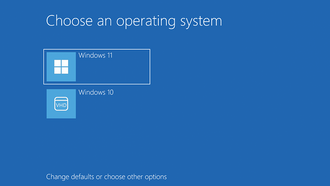Software:Windows Boot Manager
 Windows Boot Manager operation system select menu | |
| Other names | BOOTMGR |
|---|---|
| Developer(s) | Microsoft |
| Operating system | Windows |
| Predecessor | NTLDR |
| Type | Bootloader |
| License | Proprietary |
The Windows Boot Manager (BOOTMGR) is the bootloader provided by Microsoft for Windows NT versions starting with Windows Vista. It is the first program launched by the BIOS or UEFI of the computer and is responsible for loading the rest of Windows.[1] It replaced the NTLDR present in older versions of Windows.
The boot sector or UEFI loads the Windows Boot Manager (a file named BOOTMGR on either the system or the boot partition), accesses the Boot Configuration Data store and uses the information to load the operating system through winload.exe or winresume.exe.[2]
Launching
On system with BIOS firmware, the BIOS invokes MBR boot code from a hard disk drive at startup. The MBR boot code and the VBR boot code are OS-specific. In Microsoft Windows, the MBR boot code tries to find an active partition (the MBR is only 512 bytes), then executes the VBR boot code of an active partition. The VBR boot code tries to find and execute the bootmgr file from an active partition.[3]
On systems with UEFI firmware, UEFI invokes bootmgfw.efi from an EFI system partition at startup, starting the Windows Boot Manager.
Operation
Once launched the Windows Boot Manager reads the Boot Configuration Data to determine what operating systems are present and if it should present the user with a menu allowing them to select which operating system to boot. Before Windows Vista, this data was contained in boot.ini.
These menu entries can include:
- Options to boot Windows Vista and later by invoking winload.exe.
- Options to resume Windows Vista and later from hibernation by invoking winresume.exe.
- Options to boot a prior version of the Windows NT family by invoking its NTLDR.
- Options to load and to execute a volume boot record.
Operating system loading
The operating system is loaded by individual boot loaders for each install of Windows, called the Windows Boot Loader.
winload.exe
The Windows Boot Manager invokes winload.exe—the operating system boot loader—to load the operating system kernel executive (ntoskrnl.exe) and core device drivers. In that respect, winload.exe is functionally equivalent to the operating system loader function of NTLDR in prior versions of Windows NT. In UEFI systems, the file is called winload.efi and the file is always located at \windows\system32 or \windows\system32\boot.
winresume.exe
If the computer has recently hibernated, then bootmgr will instead invoke winresume.exe. In UEFI systems, the file is called winresume.efi and is always located at \windows\system32 or \windows\system32\boot.[4]
Boot Configuration Data
Boot Configuration Data (BCD) is a firmware-independent database for boot-time configuration data.[5] It is used by Microsoft's Windows Boot Manager and replaces the boot.ini that was used by NTLDR.
Boot Configuration Data is stored in a data file that has the same format as Windows Registry hives and is eventually mounted at registry key HKEY_LOCAL_MACHINE\BCD00000[6] (with restricted permissions[7]). For UEFI boot, the file is located at /EFI/Microsoft/Boot/BCD on the EFI System Partition. For traditional BIOS boot, the file is at /boot/BCD on the active partition.[8]
bcdedit
| Developer(s) | Microsoft |
|---|---|
| Operating system | Microsoft Windows |
| Type | Command |
| License | Proprietary commercial software |
| Website | docs |
Boot Configuration Data may be altered using a command-line tool (bcdedit.exe), using the Registry Editor[6] (regedit.exe), using Windows Management Instrumentation, or with third-party tools such as EasyBCD, BOOTICE,[9] or Visual BCD Editor.[10]
Boot Configuration Data allows for third-party integration, so anyone can implement tools like diagnostics or recovery options
See also
- Booting process of Windows NT
- Windows Vista I/O technologies
References
- ↑ barrygolden. "Boot and UEFI - Windows drivers" (in en-us). https://learn.microsoft.com/en-us/windows-hardware/drivers/bringup/boot-and-uefi.
- ↑ "The Windows NT 6 boot process". Frequently Given Answers. https://jdebp.eu/FGA/windows-nt-6-boot-process.html.
- ↑ "Boot Sequence of Windows Multi-Boot - Multibooters.com". http://www.multibooters.com/guides/boot-sequence-of-mixed-windows-multiboot.html.
- ↑ Hudek, Ted; Marshall, Don; Graf, Eliot (23 April 2019). "Overview of Boot Options in Windows" (in EN). Microsoft. https://docs.microsoft.com/en-us/windows-hardware/drivers/devtest/boot-options-in-windows.
- ↑ Marshall, Don. "Overview of Boot Options in Windows - Windows drivers" (in en-us). https://learn.microsoft.com/en-us/windows-hardware/drivers/devtest/boot-options-in-windows.
- ↑ 6.0 6.1 Russinovich, Mark (8 November 2011). "Fixing Disk Signature Collisions". Mark's Blog. Microsoft TechNet (Microsoft Corporation). https://docs.microsoft.com/en-us/archive/blogs/markrussinovich/fixing-disk-signature-collisions.
- ↑ "Why can't I edit the system BCD store via regedit?". http://superuser.com/questions/654971/why-cant-i-edit-the-system-bcd-store-via-regedit.
- ↑ Microsoft. "Knowledge Base Article ID: 2004518". https://support.microsoft.com/en-us/kb/2004518.
- ↑ Pauly. "BOOTICE board index". http://bbs.ipauly.com/viewforum.php?f=2.
- ↑ Bo Yans. "Visual BCD Editor". http://www.boyans.net.
Further reading
- "The Windows NT 6 boot process". Frequently Given Answers. https://jdebp.eu/FGA/windows-nt-6-boot-process.html.
 |

